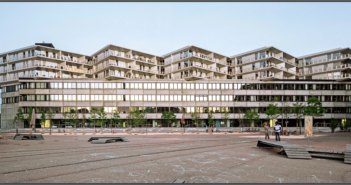This is a series of MIPIM Connect session reports from partner schools. In this post, University of San Diego reports on Major Implications of COVID-19 on the Office Sector. Watch this session below, and more in our MIPIM Connect playlist on YouTube!
The fact that you are likely reading this article from home is a testament to the shifting work dynamics as a result of the COVID-19 pandemic. Remote working has been proven to be effective and has been embraced by a large percentage of the workforce. This has major impacts on the office space market and on major occupiers as they consider changing real estate needs. Andy Pyle, Partner and Head of UK Real Estate at KMPG, and Courtney Fingar, Editor-in-Chief at NS Media Group, dug into the major implications of COVID-19 on the office sector and how the built environment and occupier considerations may change as a result.
To begin the conversation, Pyle stated that there has been a historical trend toward mass urbanization, driven by a significant increase in white collar jobs located in city offices. This has bolstered the office market on a global level. The question, he points out, is to what extent that tailwind carries on after the disruption of COVID-19. Yet, manufacturing and farming are already fairly automated, so it is unclear where more office employees will originate from. Further, a significant number of employees around the globe continue to work remotely, many of whom will not return until a vaccine is available. As a result, co-working and shrinking square footage per worker trends have come to a screeching halt.
Fingar elaborated on this narrative of the “death of the office” and wondered if this has been overstated. Pyle replied that offices will continue to be important to attract and retain a talented and engaged workforce.
Speaking as a Partner of KPMG who employs over 16,000 people in the UK and 200,000 people globally, we see the office as fundamental in how we do things – Pyle
He stated that certain things are easier when you put people in a room together, such as project work, creativity, and innovation. Yet, in-person interaction and mentorship benefit junior employees more than senior staff members. Younger people, who have less virus fatality risk and are living in small apartments, are ready to return. Senior staff, who can effectively conduct business remotely, are far less eager.
Pyle acknowledged that major corporate occupiers are away from their offices and their businesses appear to be fine operating remotely. “The leaders of those businesses are looking very hard at their cost base and are challenging those responsible for corporate real estate to reduce costs.” He stated that “there are going to be some challenges the industry will see from corporate occupiers.”
I think we will see fewer people commuting five days a week to do relatively routine tasks in a head office. Instead, [they will]go in two or three days a week on a rotational basis to meet their teams and feel part of the organization, and actually do the bulk of their task-based work remotely – Pyle
A JLL Research study echoes this sentiment. It claims 30% of all office space will be flexible by 2030. This type of space is easier to acquire and smaller, satellite offices reduce commute times and dependence on public transport.
Getting to the heart of the conversation, Fingar asked what these changes meant for investment yields. Pyle replied that, in the short term, there have been very few transactions due to problems quantifying the impact of COVID-19 on values. He stated that office rent collections have held up very well but does not believe there will be an increase in demand due to social distancing needs. “If you see big occupiers removing 20, 30, or 40% of their space – and those are the numbers that I have spoken to big occupiers about – I think that will have a softening impact on both yields and rent levels in major markets.”
If the office tenant base shrinks its footprint, office asset values will decline because income and values are directly proportional. Yet, does remote working reduce the overall demand for office space by 40%? Those numbers reflect the current loss in value of hospitality and retail assets in the public markets. Brett White, CEO of Cushman and Wakefield expects a reduction of office space demand of 5-10%, based on a survey of over 50,000 individuals. If larger occupiers dramatically reduce footprints, then the tenant mix in an office building will likely be filled by more diverse, smaller occupiers taking less space on flexible terms. This provides opportunities for these smaller occupiers to access premium real estate previously unavailable to them, but it will require a partnership with landlords for capital to demise the larger floorplates.
Shifting the conversation, Fingar asked what the role of technology would be in the shaping the built environment. Pyle responded that technology will be vital to make people feel safe as they return to the office. He pointed out this can be accomplished by a smartphone that is integrated with the building’s air quality sensors, and that shows congestion levels within the property and on public transport.
Real estate investors will begin to see that [technology]is actually important because ultimately a smart building is safer and produces better well-being for the people within it. This will mean more rent and higher values for those buildings – Pyle
Yet, it remains to be seen how urban offices can logistically provide necessary safety measures, irrespective of technology’s help. If only four people are allowed in an elevator, how long will the queue be in a high-rise building at peak times – hours? The American Society of Heating, Refrigerating and Air-Conditioning Engineers stated recirculated air should include 20% of outdoor air to effectively dilute coronavirus particles. Increasing the amount of outdoor air by 50% will drive up natural gas or electricity costs by as much as 15%. Even if technology can provide data to occupants, property owners will still need to solve logistical and cost issues because the data, however helpful, will not in itself provide the safety.
The conversation closed with a sense of optimism. Pyle stated that fundamentals like population growth and the need for housing will continue to be demand drivers despite the pandemic.
I can already see some green shoots in the UK; people are looking at deals. And if there is a bit more distress in the real estate market, there is also a wall of capital that will be looking for these opportunities. I think the back half of 2020 and 2021 could see some really good [investment]opportunities – Pyle



